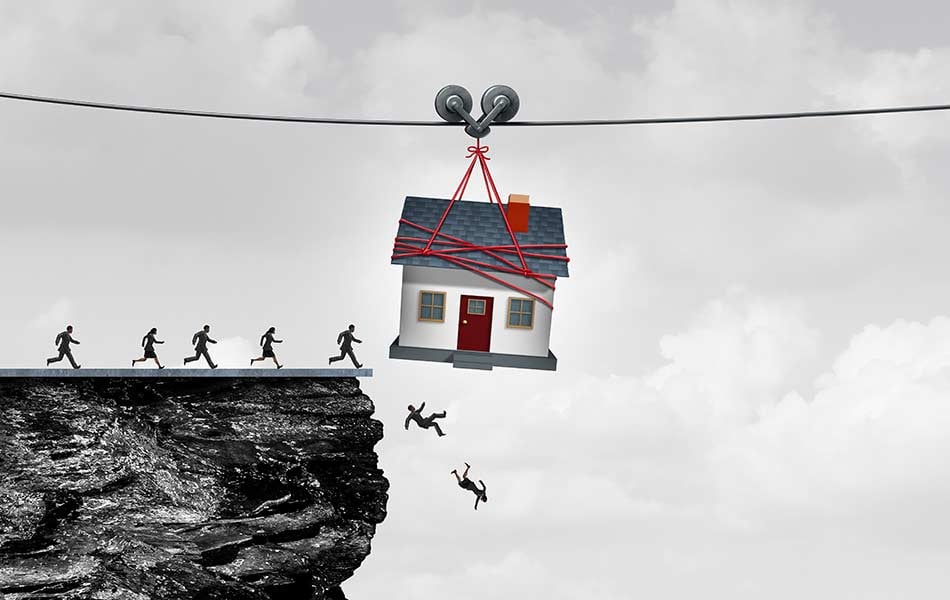One of the lessons learned from the housing crisis of the last decade was that an increase in mortgage fraud is a key red flag. Such fraud occurred in many forms—in fact, examples of just about every form of such fraud was discovered in the post-mortem examinations of the housing market’s collapse.
Perhaps the most common form of mortgage fraud was fraudulent income claims, with buyers forging bank statements, W-2s and credit reports. This falsified paperwork gave the impression of trustworthiness where there was none to be found.
These and other forms of mortgage fraud were not rare, nor did they only become a serious issue immediately prior to the market downturn. In September of 2004, years before prices peaked, the FBI issued a report stating that what it considered to be a “growing epidemic” of mortgage fraud could cause the housing market to collapse.

A form of fraud that was a favorite of unethical house flippers prior to the market crash was occupancy fraud.
A buyer would indicate that they intended to occupy a home they were purchasing, when in fact it was an investment property. These false claims led to banks offering loans with interest rates up to 40% lower than loans offered to property investors. In a report assembled by the U.S. Department of Housing and Urban Development on “The Root Causes of the Foreclosure Crisis,” an examination by the Fitch Rating Agency of early payment defaults in 2006 found that two-thirds of the foreclosed properties had never been occupied by the buyers. In 2005, the Prieston Group, a mortgage fraud insurer, identified occupancy fraud as being the most prevalent form of mortgage fraud, representing 53% of fraudulent claims.
After the market collapse, examinations of foreclosed properties showed that non-occupying investors represented an outsized proportion of mortgage defaults in housing markets across the country, including:
- 60% of foreclosures in Las Vegas in 2007
- 60% of 15,000 foreclosures in New York City were 2 to 4 family MFRs owned by investors
- 44% of 11,967 foreclosures of residential properties foreclosed between 2007 and 2009
- 32% of all prime mortgage defaults in Nevada
- 25% of defaults in Florida
- 21% of defaults in California
It was evidence of a deeply flawed period of inadequate caution and due diligence that affected every financial sector. But that was the past, right? Unfortunately, no.
Mortgage fraud is once again on the rise, as homebuyers chase properties they cannot truly afford.
Throughout much of 2018, Fannie Mae has been warning lenders that a new form of mortgage fraud is on the rise in California. This scam involves the use of online services to generate false employment and income statements involving fictitious employers. Some of these scams have been so detailed as to involve answering services which impersonate the named employers, falsely confirming the applicant’s income and employment claims.
Meanwhile, tried and true methods of fraud are beginning to show up, but with interesting new wrinkles. Four real estate executives were indicted in New York for taking out $170 million in loans after falsifying occupancies in multi-family units.
Income is typically verified by lenders for single family home purchases. However, when it comes to MFRs lenders instead review occupancy rates to ensure that properties produce enough revenue to cover the loans. In this case, the real estate execs made empty units look occupied by turning on TVs or radios, placing welcome mats outside doors, and even paying people to act like they and their families lived in the units. Worryingly, many of the loans on these residences were bundled and sold as mortgage-backed securities, including $1.5 billion in securities sold by Fannie Mae and Freddie Mac.
In October 2018, Corelogic, a firm which conducts in-depth analysis of the American housing market, published a report stating that mortgage fraud increased 12% year-over-year at the end of the second quarter. They found that one out of every 109 mortgage applications were fraudulent in some respect. The form of mortgage fraud that increased the most was the reporting of exaggerated income, which was up 22%. Borrowers often took the route publicized by Fannie Mae—using online services to produce falsified income statements and using answering services to verify this income. Occupancy fraud is also on the rise again, due in part to renewed interest in home flipping and buying rentals.
While mortgage fraud does not appear to be anywhere near as pervasive as it was in the years before the collapse, lenders and any other impacted parties should exercise proper precautions. Prices are high, and would-be buyers are fearful that prices are going to continue to rise and they will miss out. Thus, there is a great deal of incentive to inflate or entirely falsify income to meet lending requirements.
The takeaway for lenders and mortgage pool investors is this: With the risk of mortgage fraud and inflated income reports on the rise, and prices at all-time highs, it is prudent to tighten your loan-to-value (LTV) rates. This is an unpopular strategy, but the events of the last down cycle should have reinforced the value of prudency. Tightening LTVs will not only protect your loans, but also the ability of borrowers to pay off the loans in a downturn.
